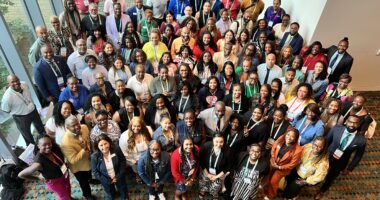Hispanic Heritage: Addressing Inequities and Celebrating Culture
This Principals’ Voices in School Equity blog post highlights resources school leaders can use to create equitable learning environments for Latino students and celebrate Hispanic heritage.

Hispanic Heritage Month, which runs from Sept. 15 to Oct. 15, is a time to pay tribute to the rich Hispanic history and accomplishments and celebrate the traditions and cultures that have influenced—and continue to influence—our country. It’s especially important to lift up these voices and stories in schools, where nearly a third of K-12 students identify as Latino, despite remaining underserved and underrepresented in schools, according to The Education Trust.
Below are resources school leaders can use to create safe, equitable, and welcoming learning environments for Latino children in the classroom and celebrate Hispanic heritage this month and year-round.
Equitable Learning Environments for Latino Students
- Getting Latino Students Better Access to Non-Novice Teachers: Having a veteran teacher matters to student learning, yet students of color and students from low-income backgrounds are more likely to attend schools with greater numbers of inexperienced teachers than their peers. This brief, from The Education Trust, highlights key findings and sets up a roadmap to success to use data, goal-setting, and transparency to make changes in schools.
- Digital Museum Resources to Cultivate Learning: Smithsonian and classroom educators model inquiry-based teaching techniques, analysis and discussion strategies, and ready-to-use activities for diverse learning environments. Topics include exploring identity through playful art making, deconstructing text with critical reading, connecting through family stories, building community through art, and more.
- Celebrating Heritage and History: From the NAESP Principals’ Voices in School Equity blog series, learn strategies to ensure your school library and classrooms offer a variety of literature that represents all students and that teachers select content and books that reflect their students.
- Leading Change to Overcome Implicit Bias in Schools: Another in the Principals’ Voices in School equity series, this blog post identifies five ways school leaders can make a conscious effort to focus on overcoming implicit bias to lead change in schools by taking note of their bias first, leading staff to identify their implicit bias, and finding lead ambassadors to offer feedback.
- Targeting Resources From the American Rescue Plan (ARP) for English Learners’ Needs: The Education Trust highlights how ARP funds can be used to support English learners to allow these students to thrive. The resource notes three principles leaders must keep in mind when addressing this issue: collaboration with families and community members, thinking big with evidence-based strategies, and providing flexibility to students and families.
Celebrating Hispanic Heritage Year-Round
- Virtual Hispanic Heritage Month Exhibits: Can’t make it on a school field trip to Washington, D.C.? The National Museum of the American Latino brings the learning to you with virtual exhibits like ¡Presente! A Hispanic History of the U.S., Mapping the U.S. Latino Experience, and Tree of Life Virtual Tour.
- Design It Yourself Mini-Exhibit: The Smithsonian Learning Lab offers the opportunity for older elementary and middle-level students to use objects they have in their homes to design mini exhibits to tell stories about themselves to celebrate their own personal history and culture.
- Top 8 Reasons Why and How We Celebrate Hispanic Heritage Month: Explore the origins of Hispanic Heritage Month, how food serves as a common language to bring people together, the role baseball played in Latino community-building, and more.
- 30 Inspiring Latinas/Latinos Who Have Shaped the U.S.: Nuestra América is a fully illustrated anthology featuring the inspiring stories of Latinas/os/xs that celebrates their cultural, social, or political contributions to the U.S.




